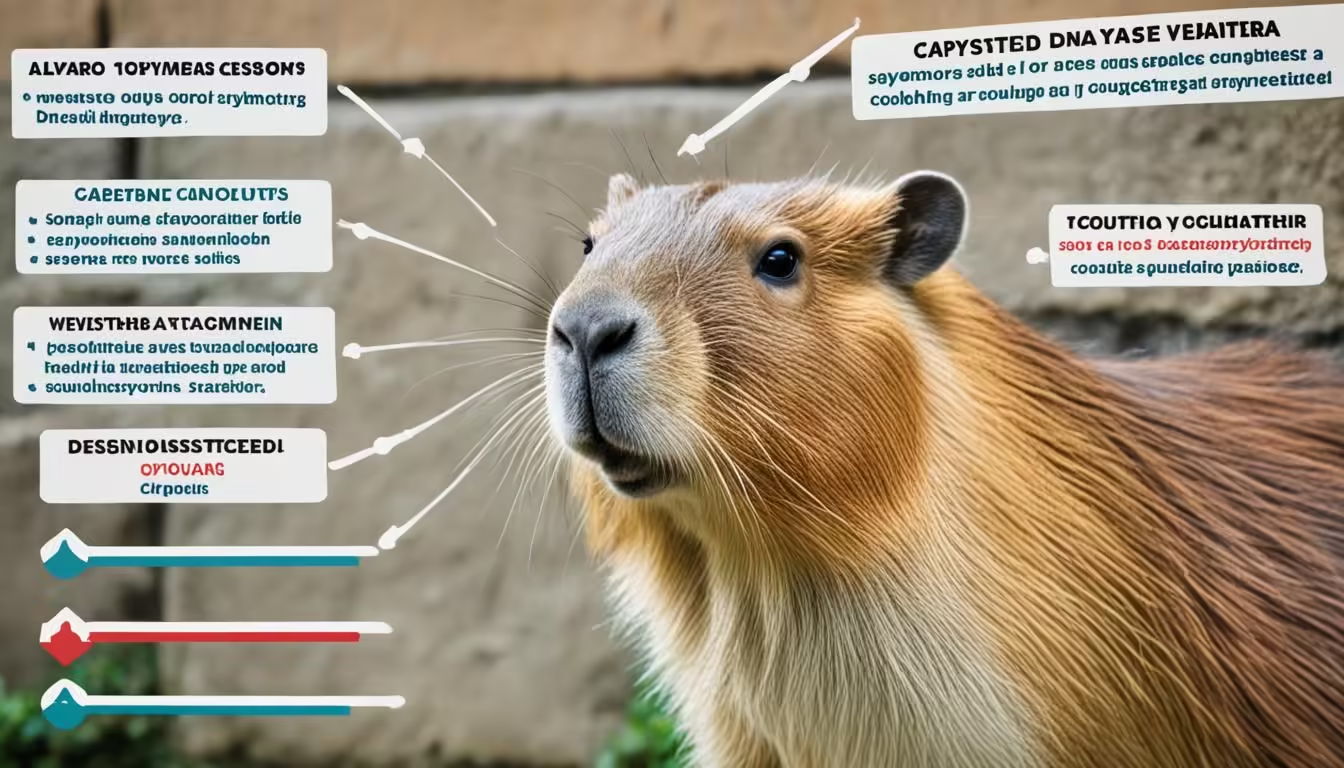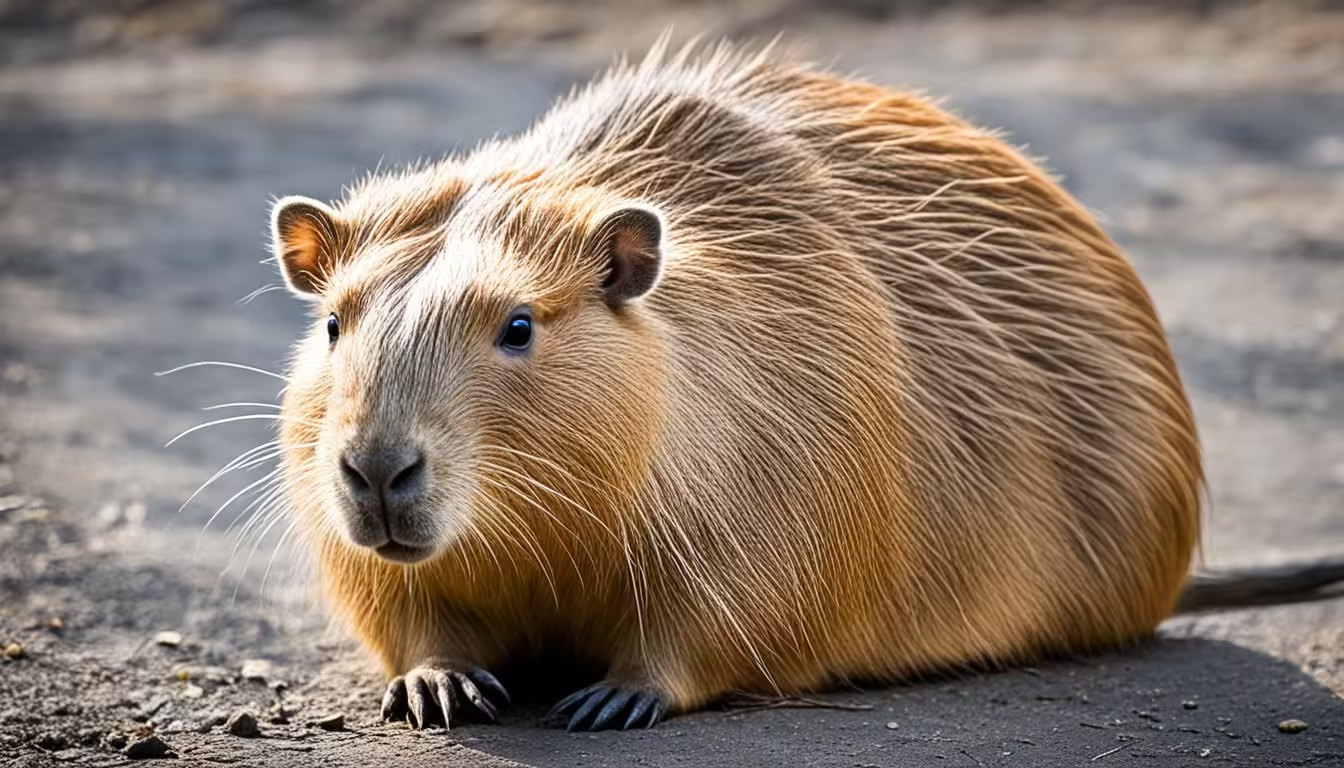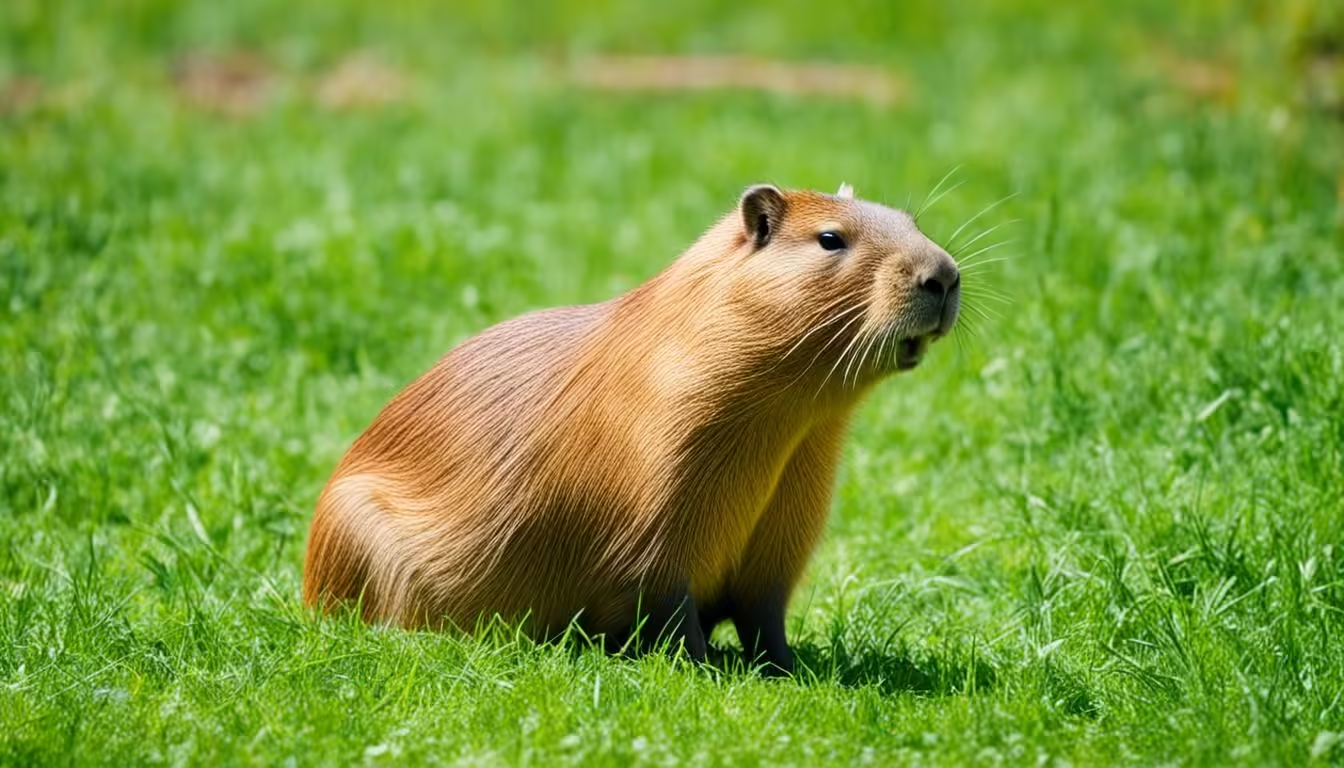Capybaras play a big role in spreading diseases to humans and other animals. These diseases include viral, bacterial, fungal, and parasitic diseases. They can carry orthopoxvirus, coronavirus, leptospirosis, salmonella, fungal infections, and common parasites like Protozoophaga sp., Viannella spp., Strongyloides spp., and Ancilostomatidae. They might also have ticks, such as Amblyomma sp., which carry Rickettsia bacteria.
This can be a big risk for public health, especially where capybaras live near people.
Key Takeaways
- Capybaras can carry a variety of viral, bacterial, fungal, and parasitic diseases that can be transmitted to humans and other animals.
- Common diseases associated with capybaras include orthopoxvirus, coronavirus, leptospirosis, salmonella, and various parasitic infections.
- Capybaras may harbor ticks, such as Amblyomma sp., which can vector Rickettsia bacteria and other pathogens.
- Exposure to capybara-borne diseases and vectors can pose significant public health risks, especially in areas where capybara populations overlap with human settlements.
- Understanding the potential health risks associated with capybaras is crucial for disease prevention and control measures.
Introduction to Capybara Diseases
Capybaras, the world’s largest rodents, are key players in disease ecology in Latin America. These semi-aquatic mammals live near humans and can carry many pathogens. These include viruses, bacteria, fungi, and parasites that affect both animals and humans. It’s vital to understand capybara diseases to protect public and wildlife health.
Capybaras can spread diseases to humans and animals because of their size and social nature. They live in large groups and often interact with other animals and humans. This increases the risk of disease spreading. Research has shown that capybaras carry many pathogens, highlighting the need for better disease management.
This section will look at the infectious diseases capybaras can carry. We’ll focus on viruses, bacteria, fungi, and parasites. By understanding how these diseases spread and affect people, we can work on preventing and managing them. This will help protect areas where capybaras live.
Viral Diseases Carried by Capybaras
Capybaras, the largest rodents, carry several viral pathogens. These pathogens can threaten both human and animal health. They have been found to have orthopoxvirus and coronavirus infections. This raises concerns about their role in spreading capybara viral diseases and zoonotic viral diseases from capybaras.
Orthopoxvirus and Coronavirus Infections
Orthopoxviruses, which include the smallpox virus, have been found in capybara stool samples. This suggests possible exposure or infection. Also, capybara coronavirus infections, including SARS-CoV-2, have been detected. This raises concerns about their role as reservoirs for emerging zoonotic viral diseases.
Capybaras can carry these viral agents, which is why ongoing surveillance is crucial. Veterinary and public health experts must work together. They need to monitor and manage the risks from these viral diseases carried by capybaras.
“The presence of orthopoxvirus and coronavirus in capybara populations underscores the need for vigilant monitoring and risk mitigation strategies to protect both human and animal health.”
As human settlements and natural habitats get closer, understanding capybaras and viral pathogens is key. Taking proactive steps to track and control capybara viral diseases can protect communities and ecosystems.
Bacterial Diseases in Capybaras
Capybaras, the largest rodents, carry several harmful bacteria like Leptospira spp. and Salmonella spp. These bacteria can harm capybaras and also threaten human health. They can spread diseases from animals to people.
Leptospirosis and Capybaras
Leptospirosis is a serious disease found in capybaras worldwide. Studies show up to 43.9% of capybaras in some places have this infection. These bacteria can be found in their urine and feces, making them a risk to humans and other animals.
Salmonella Infection in Capybaras
Salmonella bacteria have been found in capybara feces too. But, we need more research to understand how common this is and its impact on health. Since capybaras can carry these bacteria, it’s vital to watch for diseases and take steps to prevent them.
| Bacterial Disease | Prevalence in Capybaras | Zoonotic Potential |
|---|---|---|
| Leptospirosis | Up to 43.9% seroprevalence | High, capybaras can act as reservoirs |
| Salmonellosis | Isolated from fecal samples, prevalence unknown | Moderate, further research needed |
These diseases in capybaras, like capybara leptospirosis and capybara salmonella, are a concern for public health. We need to keep watching and studying these diseases to protect people and capybaras.
Fungal Infections in Capybaras
While we often talk about viral and bacterial diseases in capybaras, these big rodents can also carry fungal pathogens. But, there’s not much info on fungal infections in capybaras because they haven’t been studied much.
Recent studies haven’t found any harmful fungi in capybara hair samples. This means these animals might not spread zoonotic fungal infections much. This is key to know, as it shows we need to keep watching and researching to understand how capybaras affect fungal diseases.
Even without strong evidence, the way capybaras, humans, and other animals interact could still pose risks. By keeping an eye out and learning more, we can figure out the health risks and how to prevent fungal diseases in capybaras.
“Continued monitoring and research are necessary to fully understand the role of capybaras in the epidemiology of fungal diseases.”
Parasitic Diseases of Capybaras
Capybaras, the largest rodents, carry many parasites like protozoa, nematodes, and arthropods. Studies show they have several parasites that affect them.
Common Parasites Affecting Capybaras
Researchers found these parasites in capybaras:
- Protozoophaga sp., a protozoan parasite
- Viannella spp., a genus of nematode worms
- Strongyloides spp., a genus of intestinal nematode worms
- Ancilostomatidae, a family of hookworms
These parasites are often found in capybara feces. This shows that capybaras can host these parasites. It’s important to watch for capybara parasitic infections to keep them healthy.
Capybaras can also have ticks, like the Amblyomma genus. These ticks can spread diseases to humans and other animals by touching capybaras or their living areas.
| Parasite | Prevalence in Capybaras | Potential Impacts |
|---|---|---|
| Protozoophaga sp. | Over 70% | Potential transmission to humans and other animals |
| Viannella spp. | Over 70% | Potential impact on capybara health and fitness |
| Strongyloides spp. | Over 70% | Potential zoonotic transmission to humans |
| Ancilostomatidae | Over 70% | Potential health issues in capybaras |
| Amblyomma ticks | Highly prevalent in endemic areas | Vector for Rickettsia bacteria, risk of transmission to humans |
These parasites are common in capybaras and can spread to humans and other animals. Understanding common parasites in capybaras is key to protecting public health and the environment.
Zoonotic Diseases Transmitted by Capybaras
Capybaras, the world’s largest rodents, can carry zoonotic diseases that can spread to humans and other animals. They have been found to carry pathogens like orthopoxvirus, coronavirus, Leptospira, Salmonella, and parasites. This raises concerns about their role in spreading infectious diseases.
Capybaras live close to humans and interact with domestic animals, making it easier for these diseases to spread. It’s important to watch closely and take steps to reduce the risks of capybara-borne diseases.
A study in Acre, Brazil, looked at 162 samples from 54 capybaras. It found that 5% of the samples had Salmonella spp. through bacterial culture. Another 7% tested positive for Salmonella through PCR analysis, with 8 out of 54 capybaras showing positive results.
Also, nontyphoidal Salmonella gastroenteritis affects about 93.8 million people every year, leading to 155,000 deaths. Capybaras are a key factor in spreading zoonotic diseases. Only two cases of Salmonella in capybaras have been reported, both in captive ones.
Brazilian spotted fever (BSF) is another disease linked to capybaras. From 2001 to 2018, there were 489 confirmed cases in southeastern Brazil, with 50% of those cases being fatal. A study from 2015 to 2019 found a lot of Amblyomma sculptum ticks on capybaras in areas where BSF is common.
Wild Norway rats and capybaras can carry enteric viruses. They can also shed SARS-CoV-2 in their feces, which could spread COVID-19 to people and the environment. This shows how important it is to understand the zoonotic potential of capybara-borne diseases.
Research and monitoring are key to tracking zoonotic pathogens in capybaras. This helps in taking steps to reduce the risks of capybara-borne diseases.
| Zoonotic Disease | Pathogen | Prevalence in Capybaras | Public Health Impact |
|---|---|---|---|
| Salmonellosis | Salmonella spp. | 5-7% positive in study | 93.8 million cases, 155,000 deaths annually |
| Brazilian Spotted Fever | Rickettsia rickettsii | 489 confirmed cases, 50% fatality rate | Tick-borne disease with high mortality |
| Coronavirus Infections | SARS-CoV-2 | Detected in capybara feces | Potential role in person-to-person transmission |
| Orthopoxvirus Infections | Orthopoxvirus | Molecular evidence in capybara stool | Potential zoonotic transmission |
The findings show the public health risks from zoonotic diseases spread by capybaras. It’s vital to keep an eye on these diseases and take steps to stop them from spreading. This will help protect public health and prevent the spread of capybara-borne diseases.
What Diseases Do Capybaras Carry?
Capybaras, the largest rodents, carry many infectious agents. These can be harmful to humans and animals. They have a variety of viral, bacterial, fungal, and parasitic pathogens.
On the viral side, capybaras can spread Orthopoxvirus and coronavirus. They also carry leptospirosis and salmonella, which are bacterial diseases. Though not much is known about fungal infections, they might carry some fungal pathogens.
Parasitic diseases are another concern. Capybaras have parasites like Protozoophaga sp., Viannella spp., Strongyloides spp., Ancilostomatidae, and Rickettsia. These pathogens associated with capybaras can harm both humans and animals, especially where they live near people.
We need to keep an eye on diseases in capybaras. This includes assessing risks and taking steps to prevent them. By knowing the list of diseases carried by capybaras, we can protect our communities and the environment.
Vectors and Transmission Routes
Capybaras, the largest rodents, can carry disease vectors like ticks. These ticks are key in spreading certain infectious diseases. Studies show that Amblyomma ticks live on capybaras and carry Rickettsia bacteria, causing spotted fever.
Other insects or arthropods might also spread diseases from capybaras. These vectors can pass on viruses, bacteria, or parasites to humans and animals. Knowing how these vectors interact with capybaras is vital for understanding disease spread.
Role of Ticks and Other Vectors
Research has highlighted the role of ticks in disease spread among capybaras. In Brazil, a study found most ticks were Amblyomma sculptum or Amblyomma dubitatum. 19.9% of these ticks could carry zoonotic pathogens.
Also, 39.3% of capybara blood samples tested positive for a certain pathogen. This pathogen was also found in the ticks. This shows a strong link between capybaras, ticks, and diseases like babesiosis.
| Tick Species | Percentage of Total Ticks |
|---|---|
| Amblyomma sculptum | 86.1% |
| Amblyomma dubitatum | 13.8% |
Ticks and other vectors on capybaras raise concerns about disease spread. Understanding these risks is key to preventing diseases from capybaras to humans and animals. This knowledge helps in taking steps to protect public health.
Public Health Implications
Capybaras can carry many diseases that can spread to humans. This makes them a big risk to public health. Diseases from capybaras can cause serious illnesses or even be deadly in people. It’s vital to watch for diseases, prevent them, and take steps to control them.
To reduce the risks, we need to manage wildlife populations, keep the environment clean, teach the public, and use protective gear when near capybaras. Working together between health experts, wildlife groups, and scientists is key. They must work together to fight capybara diseases and keep people and animals safe.
| Statistic | Value |
|---|---|
| Surgical procedures on immune capybaras for sterilization | 85 |
| Risky areas for Brazilian spotted fever transmission | 2 condominiums and 1 business establishment in São Paulo |
| Prevalent tick species | A. sculptum and A. dubitatum |
| Anesthesia used for surgical procedures | Ketamine hydrochloride, xylazine, and morphine |
| Time for alpha males to return to hierarchical positions post-vasectomy | 5 to 14 days |
| Recommended population monitoring duration | Indefinite |
| Contraceptive procedures performed | Tubal ligation, vasectomy, and salpingo-oophorectomy |
| pH of non-volcanic hot springs | 9.3 |
| Normal skin pH of capybaras | 8.26 |
| Skin moisture content in summer vs winter | 30.55 ± 25.27 vs 7.85 ± 6.10 |
| Skin pH in summer vs winter | 8.26 ± 0.90 vs 7.25 ± 0.70 |
| Skin melanin values in summer vs winter | 707.27 ± 71.77 vs 647.27 ± 61.45 |
| Skin erythema values in summer vs winter | 262.15 ± 41.85 vs 210.33 ± 51.88 |
| Skin sebum content range | 0 to 2 μg/cm2 |
| Hot spring main cation and anion components | Sodium ion and chloride ion |
These statistics show the big public health risks from capybara diseases. They highlight the need for good disease control measures. Working together is crucial to tackle these challenges.
Prevention and Control Measures
To control capybara diseases, we need a strong plan. It’s important to watch for and track diseases in capybaras. Teaching people and health workers about the risks and how to stay safe is key.
Setting rules for handling capybaras safely is crucial. This means making sure they live in areas away from people. It also means controlling their numbers to lower the risk of disease spread.
Working together between health, vet, and wildlife groups is vital. They need to work together to fight diseases. By focusing on both animals and people, we can keep everyone safe from capybara diseases.
- Implement disease surveillance and monitoring programs to track pathogen prevalence in capybara populations
- Educate the public and healthcare providers on capybara disease risks and recommended precautions
- Develop and enforce guidelines for safe handling and management of capybaras
- Promote habitat management and population control strategies to reduce human-capybara interactions
- Foster collaboration between public health, veterinary, and wildlife management agencies
By working together and being proactive, we can lower the risks from capybara diseases. This helps keep both people and animals healthy.
Capybaras are the biggest rodents in the world and can carry many infectious agents. These agents pose serious risks to public health. Studies show they have viruses, bacteria, fungi, and parasites that can spread to humans and animals.
This makes them important for tracking diseases and controlling their spread. Since capybaras live near people and interact with pets, it’s crucial to watch them closely. This helps prevent diseases from moving from animals to humans.
Dealing with capybara diseases needs a team effort. This includes health experts, wildlife officials, vets, and scientists. By studying capybara diseases and taking action, we can lower the risks they pose. This protects both people and animals.
Understanding capybara diseases and how to stop them is key. With ongoing research and careful actions, we can reduce the health risks from these rodents. This helps keep everyone safe.



